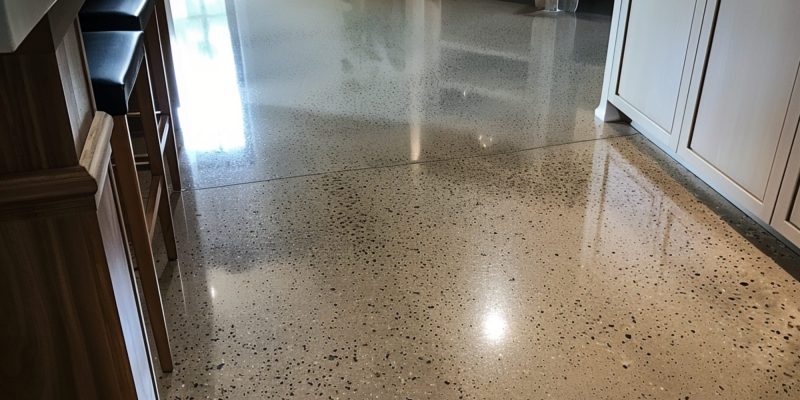Choosing the right concrete finish is more than just a final touch; it’s about bringing the best out of your construction or design project. Whether you’re laying a new driveway, sprucing up your backyard, or giving your interiors a unique touch, the finish on your concrete plays a crucial role in both the look and functionality of the space. Let’s dive into the world of concrete finishes and find the perfect match for your project!
Composition of Concrete
Concrete is a bit like a cake mix; it’s all about getting the right ingredients and proportions to ensure it turns out just right. At its core, concrete is made up of three main components:
- Cement acts as the glue, holding everything together.
- Aggregates (like sand and gravel) provide strength and texture, making the concrete sturdy.
- Water is crucial for the chemical reaction that turns the wet mix into solid concrete.
When mixed together, these ingredients harden into the durable material we use in so many construction projects. But there’s more to the mix! Additives and admixtures can be added to give concrete special properties, like extra strength, faster curing times, or resistance to freezing temperatures.
NOTE
The customization of concrete allows for various types of finishes that can be tailored to specific project needs.
Benefits of Textured Concrete
Textured concrete isn’t just about looking good; it brings a bunch of benefits to the table that can make it a smart choice for homeowners.
- Safety First: One of the top benefits is slip resistance. Textured surfaces are less slippery when wet, making them a safer option for walkways, pool decks, and driveways.
- Beauty All Around: With a range of patterns and designs, textured concrete can elevate the look of any space, adding a touch of elegance or a rustic vibe, depending on your taste.
- Built to Last: Durability is another big plus. Textured concrete stands up well to heavy traffic, harsh weather, and the test of time, keeping your spaces looking great for years.
Choosing textured concrete means you’re getting a finish that’s not only nice to look at but also practical and safe for your family.
Types, Uses, and Disadvantages of Each Concrete Finish
In the world of concrete finishes, there’s something for everyone. Each type has its own unique look, feel, and set of benefits, but they also come with their own considerations. Let’s break them down.
Each type of concrete finish has its own unique look, feel, and set of benefits…
Broomed Finish
Description: A broomed finish is achieved by dragging a broom across freshly laid concrete, creating a textured surface that improves grip and safety.
Common Uses: Ideal for outdoor spaces like sidewalks, driveways, and patios where slip resistance is important.
Disadvantages: The texture can be a bit rough on bare feet and may accumulate dirt more easily than smoother finishes.
Colored Finish
Description: By adding pigments to the concrete mix or applying a color hardener, you can achieve a wide range of colors that last long and resist fading.
Common Uses: Great for adding a decorative touch to floors, walls, and outdoor areas.
Disadvantages: Color matching can be challenging for repairs or expansions later on.
Exposed Aggregate
Description: This finish reveals the aggregates (stone or gravel) in the concrete for a natural, textured look.
Common Uses: Popular for walkways, driveways, and areas where aesthetic appeal is a priority.
Disadvantages: Requires sealing to maintain its appearance and prevent staining.
Epoxy Coatings
Description: A durable, resin-based coating that can be applied over concrete to improve resistance to oil, chemicals, and stains, available in various colors and patterns.
Common Uses: Best suited for garage floors, basements, and industrial spaces.
Disadvantages: It can be slippery when wet; professional installation is recommended.
Polished Concrete
Description: Concrete that has been treated with a chemical densifier and ground down with progressively finer grinding tools, resulting in a smooth, glossy surface.
Common Uses: A stylish option for indoor floors in homes and commercial buildings.
Disadvantages: Can be slippery and requires regular maintenance to keep its shine.
Rock Salt Finish
Description: Created by pressing rock salt into fresh concrete and then washing it away once set, leaving a pitted, textured surface.
Common Uses: Excellent for pool decks and walkways where extra traction is needed.
Disadvantages: The irregular texture can be hard on bare feet and may require more maintenance to keep clean.
Stamped Concrete
Description: Mimics the look of natural stone, brick, or other materials by pressing molds into the concrete before it sets.
Common Uses: Versatile enough for patios, walkways, and even interior floors, offering a high-end look without the high cost.
Disadvantages: Can develop cracks over time, and color may fade if not properly sealed.
Stained Concrete
Description: Uses acid-based or water-based stains to penetrate the concrete and achieve vibrant colors and effects.
Common Uses: Adds a unique, custom look to floors, patios, and other concrete surfaces.
Disadvantages: The outcome can be unpredictable due to the nature of the concrete, and it requires sealing to protect the finish.
Stenciled Concrete
Description: A technique that involves applying stencils to the concrete surface before adding color or texture, creating patterns or designs.
Common Uses: Ideal for adding logos, patterns, or decorative borders to floors and walls.
Disadvantages: Requires precision and skill to achieve the desired effect, making it more costly.
Swirl Finish
Description: Achieved by using a hand trowel in a swirling motion, creating a patterned surface that is slip-resistant.
Common Uses: Commonly used on exterior concrete surfaces where aesthetics and slip resistance are desired.
Disadvantages: The swirl patterns can be inconsistent, and the technique requires a skilled hand.
Trowel Finish
Description: A smooth finish is created by using a trowel to level and compact the surface of the concrete.
Common Uses: Perfect for indoor areas where a smooth, clean look is desired.
Disadvantages: Can be slippery when wet and may show marks or imperfections more readily.
Maintenance and Care Tips
To keep your concrete finishes looking their best, here are some general maintenance and care tips:
- Regular Cleaning: Sweep or hose off debris regularly to prevent staining and buildup, especially on textured finishes.
- Sealing: Apply a sealant every few years to protect the surface from moisture, stains, and wear. This is particularly important for exposed aggregate, stained, and colored finishes.
- Avoid Harsh Chemicals: When cleaning, avoid harsh chemicals that can damage the concrete. Mild soap and water are usually sufficient.
- Prompt Repairs: Address cracks (even hairline cracks) or chips promptly to prevent further damage. Matching the finish can be tricky, so consulting a professional is often best.
By following these tips, you can help ensure your concrete surfaces remain durable and beautiful for years to come.
Conclusion
Choosing the right concrete finish can dramatically enhance the appearance and functionality of your space. Whether you’re going for the practicality of a broomed finish or the elegance of polished concrete, understanding the types, uses, and maintenance of each finish will help you make an informed decision. Remember, the key to longevity is regular care and maintenance. With the right finish and upkeep, your concrete surfaces will continue to impress for years to come.
Frequently Asked Questions
What is the best concrete finish?
The best concrete finish depends on the specific needs and preferences of your project. For outdoor areas where slip resistance is a priority, broomed or exposed aggregate finishes are excellent choices. For indoor spaces that require a sleek and modern look, polished concrete offers both beauty and durability. Consider the functionality, aesthetic appeal, and maintenance requirements to determine the best finish for your space.
What are the 2 most common types of finish put on a concrete floor?
The two most common types of finishes put on a concrete floor are polished concrete and stained concrete. Polished concrete is renowned for its high gloss and smoothness, making it ideal for modern and industrial looks. Stained concrete, on the other hand, offers a wide range of colors and patterns, allowing for customization and unique design options for both residential and commercial spaces.
What is a concrete finish?
A concrete finish refers to the final surface applied to concrete after it is poured and set. This finish can vary widely, from smooth, polished surfaces to textured or patterned designs, affecting both the concrete’s aesthetic appeal and functional properties. Concrete finishes are chosen based on the intended use of the surface, desired look, and specific performance requirements, such as slip resistance or durability.
What is the most expensive concrete finish?
The most expensive concrete finish is often polished concrete, especially when it involves intricate designs, multiple colorations, or requires extensive surface preparation. The cost is due to the labor-intensive process of grinding the concrete to achieve a high-gloss finish and the equipment and materials needed. Epoxy coatings and stamped concrete can also be costly, depending on the complexity of the designs and the size of the area being treated.
What is the smoothest finish on concrete?
The smoothest finish on concrete is achieved through polishing. Polished concrete is ground with progressively finer grinding tools until it reaches a high level of gloss and smoothness. This process not only provides a sleek and reflective surface but also enhances the concrete’s durability and resistance to wear, making it a popular choice for commercial and residential interiors.

